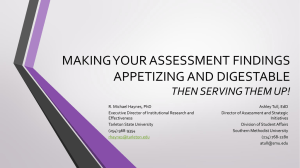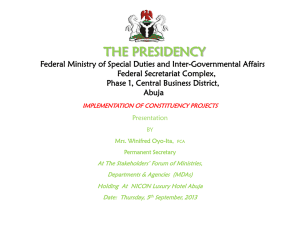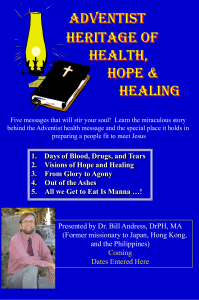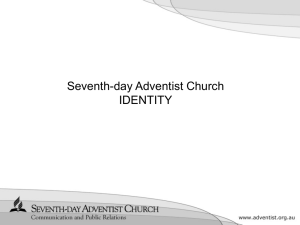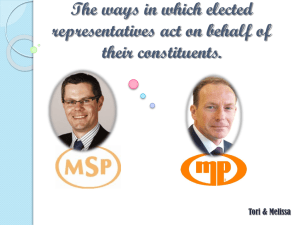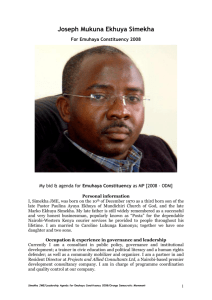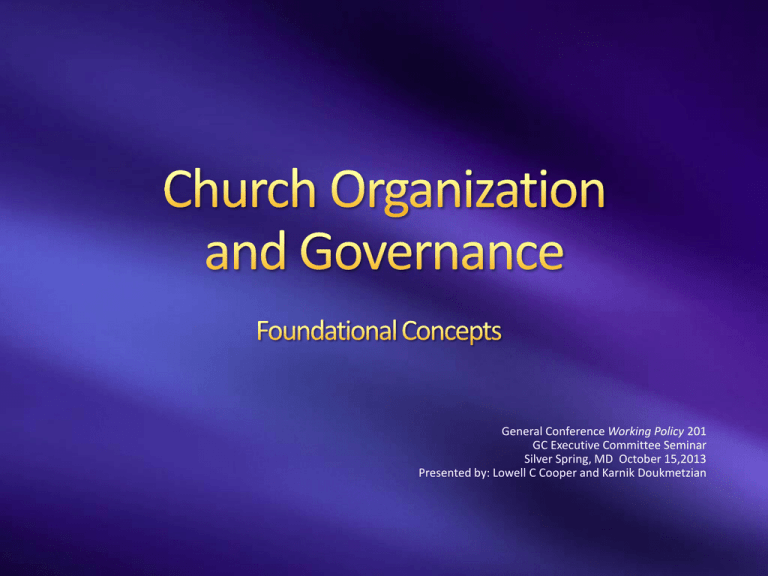
General Conference Working Policy 201
GC Executive Committee Seminar
Silver Spring, MD October 15,2013
Presented by: Lowell C Cooper and Karnik Doukmetzian
Copyright 2013 by the General Conference of Seventh-day Adventists®. All rights reserved. The
information is provided for training purposes only and is not intended nor should it be used as legal
counsel. This program may not be used or reformulated for any commercial purposes; neither shall it
be published by any person or agency other than an official organizational unit of the Seventh-day
Adventist® Church, unless prior written authorization is obtained from the General Conference of
Seventh-day Adventists® Office of Global Leadership Development. Subject to the foregoing terms,
unlimited permission to copy or use this program is hereby granted upon inclusion of the copyright
notice above. “Seventh-day Adventist” and “Adventist” are registered trademarks of the General
Conference of Seventh-day Adventists® and may not be used by non-Seventh-day Adventist entities
without prior written authorization from the General Conference. Use of all or any part of this
program constitutes acceptance by the User of these terms.
Know key principles of denominational
organization and how to apply them.
Understand purpose for governance
documents in the life of the church.
Comprehend importance of bylaws for orderly
conduct of constituency meetings.
Able to conduct constituency meetings in
harmony with the governance documents.
Increase knowledge of GC Working Policy and
its relevance to leadership issues.
1. Statement of Fundamental Beliefs
2. General Conference Working Policy or the
Division Working Policy
3. The Church Manual
4. Constitution and Bylaws: for conferences and institutions
5. Operating Policy: for units with ‘mission’ status
4
2012-2013
Global leadership decisions regarding how
entities live and work together. The ‘family code
of conduct.’
2012-2013
To protect the organization from:
Autocratic and erratic leadership
Merely reactive decision-making
Widely differing patterns of action
1. Defines how we do our work
2. Represents a collective decision-making
process (executive committee).
3. General Conference Working Policy is the
policy framework for the world Church.
4. The Church Manual is the policy framework
for the operations of local churches.
5. Is dynamic, can be amended.
8
Organizational Structure
Operating Principles
Procedures and Practices
Organization and Administration
GC Working Policy D 05
“…The fruitage of that concept is a representative
and constituency-based system. Its authority is
rooted in God and distributed to the whole
people of God. It recognizes the committee
system. It provides for shared administration
(president, secretary, treasurer) rather than a
presidential system.
It recognizes a unity of entities (church,
conference, union, General Conference) based on
mission, purpose, and belief that binds the
believers together in a universal fellowship. While
the integrity of each entity is recognized (church,
conference, union), each is seen to be a part of a
sisterhood which cannot act without reference to
the whole.”
1.
2.
3.
4.
5.
6.
7.
Membership basis of organization
Conferred status
Representative and constituency-based
Authority rooted in God, distributed to whole
Committee system (decisions made by groups)
Shared administration, not presidential
Unity of entities (mission, purpose, belief create bond of
fellowship)
8. Separate but not independent organizations
1. Membership basis of organization
Membership only in one place at a time
Membership required for participation in the
business meetings or to hold office
Boards and committees also have defined
memberships (What about invitees role?)
Organization
Members
Local church
Persons
Local conference/mission
Local churches
Union conference/mission
Local conferences/missions
General Conference
Union conf/missions
General Conference
and its divisions
Union
conference/mission/of
churches
Local
conference/mission
Local church
Not constituency-based units
“Divisions” of the General Conference
To facilitate its worldwide activity, the General
Conference has established regional offices,
known as divisions of the General Conference,
which have been assigned…general
administrative and supervisory responsibilities for
designated groups of unions and other church
units within specific geographic areas. (…The
division executive committee acts for the General
Conference Executive Committee in the territory
of the respective division.)
GCWP B 20 10
B 40 20 Divisions a Part of General Conference—
The larger and more extensive the work of these
divisions, and the less dependent any may
become upon help from other divisions…the
greater the necessity of holding closely together
in mutual counsel and fellowship. It is ever to be
held in mind that each division is a part of the
General Conference.
In the church of Christ, which is His body, there
can be no such thing as one part or member
independent of the whole. No division, therefore,
is free to pursue a course of action contrary to
the will of the whole, or to appropriate to itself
the authority of the General Conference in
defense of such action. Between sessions of the
General Conference, the General Conference
Executive Committee is constitutionally the final
authority throughout the world field.
GCWP B 40 20
1. Membership basis of organization
2. Conferred status
Membership is always a privilege granted by a
group (e.g. no one can baptize himself/herself)
Organizational status is never self-proclaimed
nor self-derived nor automatically perpetual
Membership is not a right
Membership can be withdrawn by the same
group that granted it
1. Membership basis of organization
2. Conferred status
3. Representative and constituency-based
In a direct democracy every member can vote
on each decision–particularly in the choice of
leaders
Representative democracy involves the
selection of representatives who then vote in
the decision-making process
Representatives are chosen by defined group
processes
1.
2.
3.
4.
Membership basis of organization
Conferred status
Representative and constituency-based
Authority rooted in God, distributed to whole
Authority of the Bible with respect to
organization
Both James White and Joseph Bates initially
claimed that organizational design should be
patterned after the “perfect system of order, set
forth in the New Testament.” (RH, Jan 23, 1855,
164).
However, by 1859 White argued that “we
should not be afraid of that system which is not
opposed by the Bible, and is approved by sound
sense.” (RH, July 21, 1859, 68 emphasis
supplied).
Authority of the Bible re: organization
Authority distributed throughout organization
Different types of authority at local church,
conference, union, division, General
Conference
Distribution of authority helps to unite the
church–no one part complete in itself
1.
2.
3.
4.
5.
Membership basis of organization
Conferred status
Representative and constituency-based
Authority rooted in God, distributed to whole
Committee system (decisions made by groups)
Most important decisions made by groups
Authority ascends to a group
Every elected/appointed leader is accountable
to a group
No group or committee has authority equal to
or greater than the group that appointed it
1.
2.
3.
4.
5.
6.
Membership basis of organization
Conferred status
Representative and constituency-based
Authority rooted in God, distributed to whole
Committee system (decisions made by groups)
Shared administration, not presidential
Officer team arrangement—not presidential
3-officer team—avoids kingly power, decreases
potential for conflict, provides specialization
President reports to Exec Comm in
consultation with co-officers
Secretary reports to Executive Committee after
consultation with the President
Treasurer reports to Executive Committee after
consultation with the President
1.
2.
3.
4.
5.
6.
7.
Membership basis of organization
Conferred status
Representative and constituency-based
Authority rooted in God, distributed to whole
Committee system (decisions made by groups)
Shared administration, not presidential
Unity of entities (mission, purpose, belief create bond of
fellowship)
Our submission to the Holy Spirit
Commitment to worldwide mission
Respect for the Church as a ‘body’
Willingness to keep striving for togetherness
Policy is the result of unity,
not the cause of it!
Growth in any organization will tend towards
fragmentation.
“Together we can do more.”
Centralization vs decentralization
The purpose of centralization is more for
coordination than for control.
The purpose of decentralization is more for
responsiveness to mission in local situations than
for independence.
1.
2.
3.
4.
5.
6.
7.
Membership basis of organization
Conferred status
Representative and constituency-based
Authority rooted in God, distributed to whole
Committee system (decisions made by groups)
Shared administration, not presidential
Unity of entities (mission, purpose, belief create bond of
fellowship)
8. Separate but not independent organizations
…each level of organization exercises a realm of
final authority and responsibility that may have
implications for other levels of organization. In a
similar manner, each organization is dependent
to some extent on the realm of authority
exercised by other levels of organization.
(B 05 cl. 6)
Congregational
Hierarchical
Interlocking and interdependent
1.
2.
3.
4.
5.
6.
7.
Membership basis of organization
Conferred status
Representative and constituency-based
Authority rooted in God, distributed to whole
Committee system (decisions made by groups)
Shared administration, not presidential
Unity of entities (mission, purpose, belief create bond of
fellowship)
8. Separate but not independent organizations
Most of the denomination’s activity is
accomplished through status as an
unincorporated entity.
However, the Church also exists in an
environment of that obligates the Church to
have ‘legal personality’ along with its privileges
and responsibilities.
A company or group of people authorized to
act as a single entity (legally a person) and
recognized as such in law
Unlike Associations, partnerships or sole
proprietorships
• In Law, treated like person
• Perpetual life
• Empowered to enter contracts, leases, borrow
money buy property, goods and services
without imposing personal liability on
individuals who carry out those activities
• Can sue or be sued
• Recourse only against legal entity not
individuals
• Liability limited to assets
• Can sell shares to raise funds
Entitled to make profits
– Owners
– Shareholders
•
•
•
•
Profit driven
Distribution of assets to owners
Can be sold
Directors can be compensated for serving on
Boards
• Usually started by a group or individual for
particular purpose
• Members
• Mission driven
• Can’t be sold, can only be dissolved
• Who owns non profit?
– No one
– Everyone
– Charities Exist for the public good-Public Purpose
(religious, educational, scientific, charitable)
Directors cannot be compensated for serving
on Board
On dissolution assets turned over to another
charity
In some instances greater scrutiny/oversight
Conference/Mission Corporations
Union Conference (Missions & Union of
Churches)
General Conference Corporation
Institutional Corporations
Who Owns The Above “Legal Persons”?
• Constituent Members & Stockholders
Corporations to serve General Conference
must be authorized by Executive Committee
(GC Constitution)
BA 25 05 GC WP The incorporation or registration of legal entities of the
Church, other than at the General Conference level, is subject to division
policy which takes into consideration the principles of denominational
organization and representation, laws of jurisdictions, and the specific
needs of the Church in the geographic areas served. Unless local laws
require otherwise, the local church operates under the legal structure of
the local conference, mission, or union of churches and not as a separate
legal entity.
• Prior Consultation and Permission (GC WP 25 10)
• Divisions have own process
– NAD Requires NADCOM Approval and also approves
Denominational Status
• Conference Corporations serve as trustees, hold
property, invest trust funds, enter into contracts,
• Operate in situations where legal status is
required
CONFERENCE
Unincorporated nonprofit association
All operational aspects of the Conference including
employees
Ecclesiastical organization
ASSOCIATION-CORPORATION
Nonprofit religious corporation
All legal aspects of property ownership, trusts
Legal organization
Some entities have merged the AssociationCorporation and the Conference into one
Reasons
Reduce liability
Local legal requirements
Confusion between dual structure
• Corporate
– Bound by local corporate law
– Constitution and Bylaws
– Board has fiduciary responsibility to members
• Ecclesiastical
– Commitment to Working Policy and Church Manual
– Unincorporated Association
– Perhaps different set of laws depending on
jurisdiction dealing with unincorporated associations
“…the accumulated policies adopted by General
Conference Sessions and Annual Councils of the
General Conference Executive Committee. It is,
therefore, the authoritative voice of the Church in
all matters pertaining to the mission and to the
administration of the work of the Seventh-day
Adventist denomination in all parts of the world.”
(GCWP B 15 05)
No departure from these policies shall be made
without prior approval from the General
Conference Executive Committee… (GCWP B 15 10)
Officers and administrators are expected to work
in harmony with the General Conference
Working Policy. Those who show inability or
unwillingness to administer their work in
harmony with policy should not be continued
in executive leadership...
(GCWP B 15 15)
Compliance with Working Policy is a standard of
conduct for Seventh-day Adventist leaders.
1. Read, understand and apply General
Conference Working Policy Section B.
2. Orient new officers of local fields and
institutions to the concepts in GCWP Section
B.
Questions or Comments?
1. The chairperson of the executive committee
frequently makes provision for ‘invitees’ to
attend executive committee meetings. As a
courtesy, the chairperson extends to the
invitees the privilege of ‘voice and vote’. How
does an understanding of operating principles
in the Church determine what the chairperson
can/cannot do in regards to granting invitees
the right to vote?
2. What holds the Seventh-day Adventist Church
together as a worldwide faith community?
3. Name four of the eight key concepts of
Seventh-day Adventist organization.
4. Why are divisions not included in the
constituency-based units of denominational
structure?
Model Constitutions
and
Operating Policies
Define identity, relationships, membership and
territory of operation
Protects the voice of the membership within
and organization
Constitutions
Bylaws
Operating policies
Official part of the Seventh- day Adventist
Church
Highest level of self- governance available
Indicates organization is net contributor to
global resources
Officers elected by the constituency session
Governance document: Constitution and
bylaws—can be amended by constituency
Official part of the SDA Church
Moving towards conference status
Organization may be a net recipient of global
resources
Officers appointed by the next higher level of
organization
Governing document is Operating Policy
approved by next higher level
Cannot amend its own operating policy.
The 54th General Conference Session, in its
consideration of the Role and Function of
Denominational Organizations, pointed out that
the constitutions, bylaws and operating policies
of all denominational organizations should be
consistent with the Seventh-day Adventist
concept of the church, its organization, and
governance.
(GCWP D 05)
Sec. 1. Regular Meeting: This union conference
shall hold a regular quinquennial constituency
meeting at such time and place as the executive
committee of the union conference shall
designate. Notice of the time and place of the
meeting of the delegates representing the
members shall be given by
a. A notice printed in the official publication
of the union conference at least four weeks
before the date of the session, or
Those sections of the model bylaws that appear
in bold print are essential to the unity of the
Church worldwide, and shall be included in the
bylaws as adopted by each union conference.
Other sections of the model bylaws may be
modified as set out in Bylaw Article XII, provided
they continue to be in full harmony with the
provisions of this model.
(GCWP D 10 05)
Constituency—a body of persons/members entitled
to make official decisions such as election of officers
and executive committees
A ‘business meeting’ of an organization’s members
The local church also has a constituency meeting but
this is ordinarily called a business meeting—all
members may attend and, unless under censure, may
participate through discussion and voting on matters
to be decided
Organization
Members
Local church
Persons
Local conference/mission
Local churches
Union conference/mission
Local conferences/missions
General Conference
Union conf/missions
Describes organization’s identity, relationships
and territory
Name
Purpose
Relationships
Geographic Territory
Membership/Constituency
Bylaws*
Dissolution/Disposition of Assets
Amendments*
* These items not in ‘Operating Policy’ for Missions
How the organization functions
Principal Office
Membership/Constituency Mtngs
Representation
Constituency Meeting Committees
Executive Committee
Officers
Directors of Depts/Assoc/Service
Other Organizations
Finance
Budget, Employee Comp…Audit
Indemnification
Amendments
The organization’s provision for the
VOICE of the MEMBERSHIP
A primary function of the Bylaws is to define the
processes whereby the membership fulfills its
authorized role in decision-making.
1. Session types: Regular or Special
1. Planning phase
2. ‘Getting started’ phase
3. ‘Doing Business’ phase
4. Closing phase
5. Documentation phase
Definition of membership
Frequency and location of constituency meetings
Period and method of meeting notice required
Delegate quotas (regular and at-large)
Outlines procedures and business of the session
Article V—Membership
The membership of this conference shall consist of such
churches as have been or shall be properly organized in
any part of the geographic territory under its jurisdiction
and formally approved for membership by vote of the
delegates at any regularly scheduled constituency
meeting.
Article II—Constituency Meetings
Sec. 1. Regular Meeting: This conference shall hold a
regular __________ (biennial, triennial, quadrennial,
or quinquennial) constituency meeting at such time
and place as the executive committee of the
conference shall designate. Notice of the time and
place of the meeting…shall be given by
a. A notice printed in the official publication of the
Union at least four weeks before the date… or
b. A method approved by the Conference
Executive Committee.
Regular delegates representing local churches in a
conference constituency are chosen at a business
meeting of the local church—not by the pastor, the
church board, or the conference administration or
committee.
1. All members of the executive committee…
2. All members of the executive committee of the
Union who may be present…
3. All employees holding credentials or ministerial
licenses issued by this conference.
4. Members of the GC Executive Committee…not
exceed ten % of total other delegates.
5. Others recommended by the executive committee
and accepted by the delegates in session…not exceed
ten % of total regular delegates
Bylaws generally indicate what Rules of Order will be
used. (i.e. General Conference Rules of Order)
Facilitate orderly group discussion and decisionmaking—courtesy, justice, impartiality, equality
Majority rules while protecting rights of the minority
The Chair may rule on issues not specifically covered
in Rules of Order. If anyone appeals the ruling of the
Chair, the matter is decided by group vote
Business is conducted one item at a time
Requires advance work by competent individuals
Must correspond to model constitution in GC Working
Policy
Proposed amendments need Conference Executive
Committee recommendation
Bylaws may specify that proposed amendments must
be included when notice of meeting is given
Bylaws changes generally require 2/3 majority vote,
not just a simple majority vote
Preparation and preservation of minutes
Printing/circulation of amended governance
documents
Letters to all persons who have been elected
What position and term of office
Notifications to other organizations regarding
elections
Arrangements for officer transitions (moving, changes
in bank account signatures, etc.)
Post-session evaluation:
What worked/didn’t work? Things to do next time.
1.
2.
3.
4.
5.
Document is out of date
Not in harmony with model documents
Not read and understood
Constituency meeting actions undocumented
Constituency meeting procedures not in
harmony with documents
6. Delayed preparation of amendments
7. Insufficient orientation of leadership
Begin preparing
for the next constituency session
NOW!
The most important
human resource for the Church is
TRUST
1. Read, study and understand the governance
document for your unit of organization.
2. Ensure that the governance document is up to
date.
3. Ensure that subsidiary units have up to date
governance documents and that leaders know
how to conduct constituency sessions.
Questions or Comments?
1. Here is a statement from a current set of
conference bylaws:
Article III Constituency Meeting Representation
The _________ Conference Executive Committee reserves the right to
accept or reject any recommendation from churches regarding delegates.
In what way does this bylaw contradict a basic
principle of denominational operation in
conference constituency meetings?
How should this bylaw be changed?
2. The Union Mission executive committee votes
‘transfer orders’ for a local conference
president to take up administrative duties in
another field.
How should this matter have been handled?
Why?
3. Compare organizations with ‘conference’
status and organizations with ‘mission’ status.
Identify at least one way in which the
organizations are similar and one way in which
they are dissimilar.
4. Why do the model governance documents
(constitutions, bylaws, operating policies) in
General Conference Working Policy contain
text in bold font as well as in regular font?
5. How can church leaders act in ways that build
membership trust—both in the leaders
themselves and in the church as an
organization?
End


